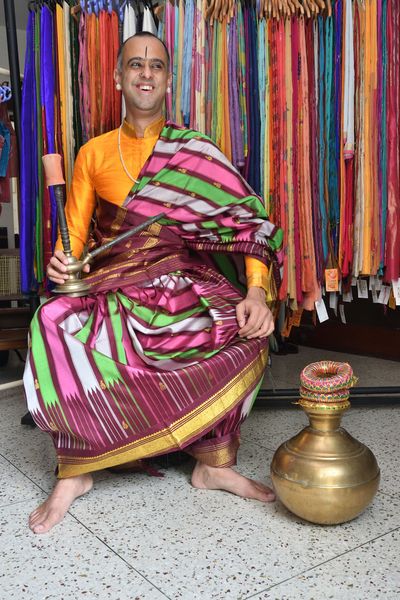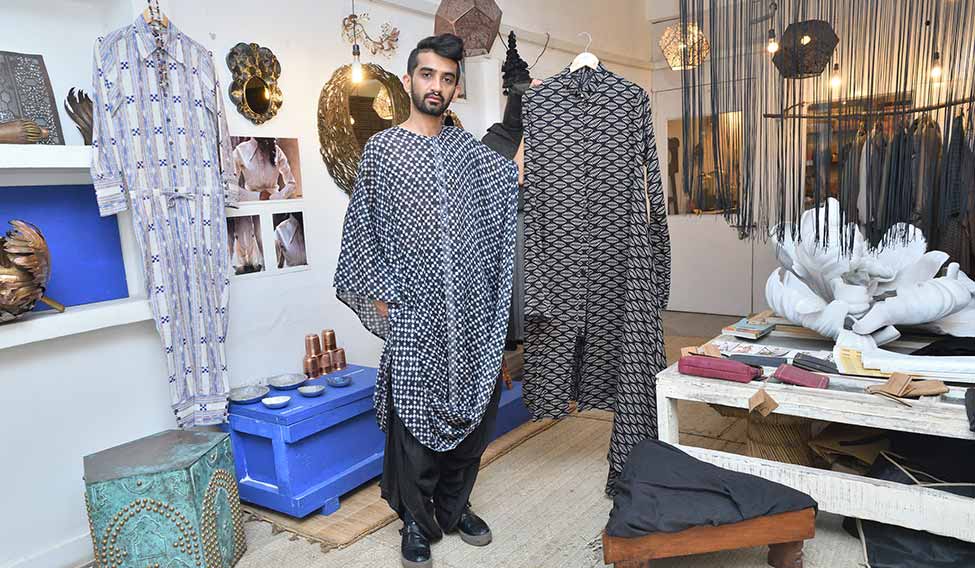People often mistake art curator Himanshu Verma for a cross-dresser. The 36-year-old Delhi resident has been wearing saris since 2006, preferably a chanderi or thicker cotton saris with simple borders and varied patterns. His love for saris, he says, stems from his love for Indian heritage. “I started wearing saris while curating art and loved them so much that I started incorporating them in my wardrobe,” says Verma, who is known as the ‘Sari Man of India’. “They are actually very gender fluid because they take the shape of the body, clearly depending on how a man or a woman drapes them. I wear them because I find them comfortable.”
While Verma has been wearing saris for more than a decade now, gender-fluid fashion became a trend in India only recently. Actor Ranveer Singh, of late, has become the face of androgynous fashion, sporting skirts and half-skirts at public events, to even a nose ring on a magazine cover.
Bengaluru-born Abhishek S. Murthy, visual merchandiser and handicraft curator at Fabindia, has been wearing saris as well as jewellery for a long time. Garment, for him, has no gender. “I believe in the beauty of the unstitched garment,” he says. “I am not doing anything new by wearing a sari. In fact, I am doing what people have done for years, centuries ago.”
 Going the whole nine yards: Art curator Himanshu Verma has been wearing saris since 2006 | Sanjay Ahlawat
Going the whole nine yards: Art curator Himanshu Verma has been wearing saris since 2006 | Sanjay Ahlawat
Verma says the attires of our gods and goddesses, too, were similar, as was their jewellery. “Lord Rama and Goddess Sita used to wear same silhouettes—a dhoti and a sari,” he says, adding that the two garments are not too different.
Fashion experts say the British changed the way we dressed, eventually diminishing the commonality between what men and women wear. But, several designers in India are now going gender-fluid with garments and drapes. While some find inspiration in intangible traditions, others say non-binary clothing gives them freedom to experiment with clothes, irrespective of who is wearing them.
Anaam is one such gender-fluid brand. “I love wearing salwars and I like experimenting with clothes,” says its founder Sumiran Kabir Sharma. “I often pick up dresses from women’s section. When I used to go to shopping malls, people often used to ask me why I was dressed like a girl or why I was picking up an outfit from women’s section. At the airport once, female security officers asked me why I was wearing salwar if I was a man. That experience rattled me and led to the birth of Anaam, my brand that makes clothes that are not gender specific and rather fluid.”
Anaam, based in Delhi, works directly on a person instead of thinking about a gender. “We do not consider the body parts that define gender,” says Sharma. Instead, they focus on, say, shoulders or arms. The brand takes inspiration from philosophy, art, life, mythology and concepts like equality. “At Anaam, we mould the ‘no gender’ concept into identity,” he says. “We always have a story behind the clothes that are created. Some of the silhouettes are drop crotch pants, tops (with asymmetric technique on bust), salwar kameez, jacket, trench coat, dhoti, lungi and kurtas. There are pieces that can be draped as well as cuts.”
Likewise, Huemn, a brand by Pranav Mishra and Shyma Shetty, too, works on the same ideology—creating clothes without considering gender as a boundary and without giving preference to colours, patterns and styles. “We believe clothes sum up our expression and should be created so that they can be transferred from one gender to another,” says Mishra.
The Delhi-based brand defines the emotional side of human beings rather than their gender. The silhouettes vary from dresses and oversized clothes to T-shirts, shirts and sweatshirts. One size doesn’t fit all, say the designer duo, and non-binary clothes give them a reason to experiment. Also, feminism has changed society, says Mishra. “Women are openly accepting men’s clothes and even men are experimenting with women’s clothes.” Though small, this change has strengthened their no-gender formula, he says.
Ujjawal Dubey, founder of Noida-based Antar-Agni, too, says that equality and feminism have been responsible for the emergence of androgynous fashion. “Gender-fluid fashion is something that a person relates to, without suiting an occasion. It is the natural self. Since the world is moving towards feminism and equality, people are becoming conscious about blurring the gender lines.”
Dubey, who creates layers, drapes, asymmetrical kurtas, tops, dresses, dhoti pants, layered pants, low crotch pants and Nehru jackets, keeps colours common to both genders. “There are plenty of earthy tones, all analogous colour schemes,” he says. So, there are lot of beiges, browns, greys and blacks, since these colours work for both men and women.
The brand also brings variation in fabric—linen, linen blends, cotton silk, lightweight and heavyweight khadi and cotton—making it easier for the wearability of both genders. “We try to develop as much as we can,” says Dubey. “We also use variations in khadi that involve changes in the weave and weight.”
What matters, however, is comfort, says Dubey. Men and women won’t mind buying gender-fluid clothes as long as they are comfortable.







